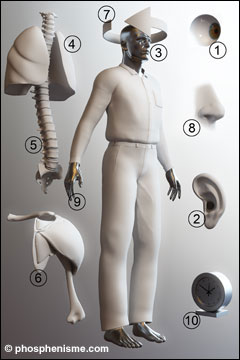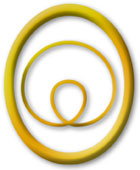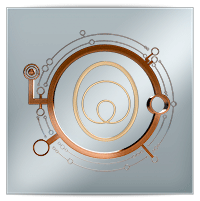GLOSSARY
THE PHENIC SYSTEM

2. Acouphene
3. Gustatophene
4. Pneumophene
5. Osteophene
6. Myophene
7. Gyrophene & Equilibrophene
8. Olfactophene
9. Tactuphene
10. Phene of Time
1. Phosphene.
The phosphene corresponds to the sense of sight.
2. Acouphene (the French word for Tinnitus).
The acouphene corresponds to the sense of hearing.
3. Gustatophene.
The gustatophene corresponds to the sense of taste. It is used in monasteries, when monks eat silently while a brother reads a text. And the host used in the Christian worship is a good way to produce it (the longer the host is kept melting on the tongue). If you remember the sensation of a taste and if you observe the evolution of your thoughts, you will notice how much your souvenirs are connected to food.
4. Pneumophene.
The pneumophene is related to the sensation of air perceived during the breathing.
5. Osteophene.
The osteophene is provoked by the bones’ vibration when the skeleton is moving.
6. Myophene.
The myophene is related to muscular activity and the cenesthesic sensations or sensations of movement (for example, the rotation one of an arm, followed by the observation of the consecutive cenesthesic sensation).
7. Gyrophene & Equilibrophene.
These phenes correspond both to the sense of balance (during rotations, for the first one, or sways, for the second one) whose center is located in the inner ear. They are the ones that produce the subjective sensation of moving or floating, the unusual perception of space, and the sensation that one’s body extends beyond the usual spatial body scheme with the impression of being larger than the limits of the body (in most cases towards the infinitely large but sometimes towards the infinitely small). And they may also induce any rhythmic pulsations of consciousness, oscillating between the infinitely large and the infinitely small.
8. Olfactophene.
This phene corresponds to the sense of smell. In sacred worships, incense is used to stimulate it. As for the gustatophene, if you try to remember the sensation of a smell and if you observe the evolution of your thoughts, your souvenirs will recall you many images related to these perfumes.)
9. Tactuphene.
This phene corresponds to the sense of touch (that is to say the subjective sensation of a tactile perception). Its manifestation allows to perceive the etheric double that is the sensation of being contained in ‟something” that is not physical; a kind of very pleasant soft wadded cocoon. Then, during out-of-body experiences, it induces the perception of the ground you walk on and the objects you touch; which are genuine sensations. And it is also related to thermal sensations like cold and heat, sensations of pressure, lightness, or emptiness.
10. Phene of time.
Certain experiences induce a loss of the normal perception of time. Often, the experiences seem to last less than their actual duration. For example, a session of an hour and half can be perceived as lasting three-quarters of an hour. Sometimes, an experience seems to take place over a long period, when it has only lasted a few seconds of real-time. The latter aspect mainly occurs in a state of half-sleep.
Moreover, there is a third sensory system, which until now has been called ‟psychic centers” or chakras. That system is connected to the phenic system. The third sensory system is related to consciousness. It is possible that, to a certain extent, these psychic centers or chakras are organs of consciousness.
PHOSPHENE:
A multi-colored patch, that persists in the field of vision for 3 minutes, in the dark, after having focused on a source of light for 30 seconds.
- The term ‟phosphene” is derived from the Greek word ‟phainein”, which means ‟to appear”, but also ‟to shine”. In 1838, the Naturalist Lelorgne de Savigny used it to name a variety of glow worms. The Physiologist Venzac used it to describe the spontaneous sensations of light.
- Doctor LEFEBURE created the term ‟Phosphenism”® from the word ‟phosphene”. The origin of that term comes from the Greek word ‟phos”, meaning ‟light”, reminiscent of Phoebus, the Sun.
THE 11 KEY WORDS OF PHOSPHENISM:
Phosphenic Mixing: it consists in associating a phosphene to a visual or auditive thought that has been prepared in advance.
Post-phosphene: this is the multicolored patch that persists in the field of vision, in the dark, for three minutes after having focused on a source of light for thirty seconds. Phosphenic Mixing consists in associating a visual or auditive thought prepared in advance to a phosphene.
Co-Phosphene: this is the phosphene that is associated to focusing on a source of light. If you focus on a source of light for more than thirty seconds, you will start to see a blue tint appear. It will eventually cover the source of light. Then, a pink color appears. These colors are also a phosphene, but a phosphene that you perceive with your eyes open, while you are focusing on a source of light.
Cerebral alternation: corresponds to the alternating functioning of the cerebral hemispheres as Dr LEFEBURE demonstrated in his book ‟Exploring the Brain through the Study of the Oscillations of Double Phosphenes”. Phosphenic techniques restore the balance between the hemispheres and thus increase cerebral capacities as a whole.
Point of concentration: this is the visualization that accompanies all the exercises. It is comprised of all the luminous mental images that tend towards the infinitely small: a dot of light, a small sun, the flame of a candle, etc.
Visual chaos (or aura): this is what we perceive in complete darkness or, in certain cases, with the eyes open. It is a variety of phosphene. It is made up of milky patches or sparks that are almost imperceptible. The practice of hunting for details in the visual chaos will allow you to organize it and, with a bit of experience, you will be able to trigger a genuine inner cinema.
Diffuse glow: this is the final phase of the phosphene. It is much paler than the others, slightly grainy and milky grey.
Phosphenic salt: in an acid/base reaction, there is the production of a salt. Dr. LEFEBURE uses this metaphor to show that during Phosphenic Mixing, through the process of combining a phosphene and a thought, a new compound is produced. One can observe that upon entering a room where a Phosphenism workshop has been conducted. The energy of the room is very intense and can almost be touched.
Phenic system: this is the whole of the phenes, i.e. the whole of the physiological intermediaries between the physical senses and the equivalent spiritual senses which, once awakened, produce the perception of intangible energies, events, or universes that cannot be perceived by the physical senses.
When the phenic system is stimulated, it provokes the perception of the spiritual planes that traditions call ‟beyond”, ‟invisible worlds”, or ‟subtle planes”.
There is an equivalent of the phosphene that corresponds to all the other physical senses, adding as well the sense of balance, muscular activity, breathing, a phene related to the skeleton, and the perception of time.
Rhythmed thinking: this consists in repeating rhythmycally the same thought. Rhythm structures thoughts and results in the amplification and accumulation of cerebral energies. That is why all the exercises of Phosphenic Mixing are practiced at a particular rhythm. The Mantratron, the Alternophone, and the Synchrophone are devices that allow one to work at a precise rhythm.
Rhythmo-Phosphenism: it is a deep study of Initiatic techniques. The latter, through the increase of cerebral rhythms and intense energies, provokes extensions of consciousness. Through amazing experiences, everyone will discover that they have a possibility of access to an inner universe that used to be reserved for a chosen few. A detailed and in-depth study of the phenomena and the initiatic experiences will allow you to discover the foundation of an ancient universal knowledge.

Explanation of the
PHOSPHENISM Logo
The Symbol of PHOSPHENISM:
Pascal’s Limaçon (placed in the center of the cosmic egg in Western esoteric teaching) is the symbol of the analogy between the macrocosm, the mediocosm, and the microcosm.
Dr. Lefebure chose this curve as the symbol of Phosphenism because it is a variety of spirals. It is thus the symbol of the original force in all things and has a whirling structure, whether it is the nebula that gives birth to star systems, the spiral of chromatin at the top of the first mitosis of an egg, or the whirling of the blood in the heart which is the center of physical life.
The oval that surrounds it represents the cosmic egg in occidental esoteric teaching. It was historically added in a second time in 1988 by Daniel Stiennon.
Finally, the external structure (see logo below) was integrated in 2005, inspired by the film STARGATE. It represents the Stargate and evokes the universe of possibilities offered by Phosphenism.

Origin of the term PHOSPHENISM:
‟Doctor LEFEBURE created the word PHOSPHENISM® by creating what is called a neologism in grammar, based on the word phosphene, whose main root means light, recalling Phœbus, the Sun.”
TERMINOLOGY:
PHOSPHENISM®:
Dr. LEFEBURE’s works as a whole.
PHOSPHENOLOGY®:
the study and the teaching of the science of phosphenes.
PHOSPHENOLOGIST©:
teacher of Initiatory techniques.
PHOSPHENO-PEDAGOGIST©:
teacher of Phosphenic Mixing applied to Education and Individual Development.
NATURO-PHOSPHENOLOGIST© (Naturophenology):
a researcher who studies the connections between the rhythms of the brain and of the rhythms of nature.
CHROMO-PHOSPHENOLOGIST©:
a researcher who is specialized in the effects of the colors of phosphenes.
PHOSPHENOMANCY©:
‟Human sciences”: based on the interpretation of signs that appear in phosphenes.
PHOSPHENOTHERAPY©:
a therapy that uses light for well-being.
PHOSPHENOTHERAPIST©:
a physician who uses the beneficial action of light on his/her patients.
